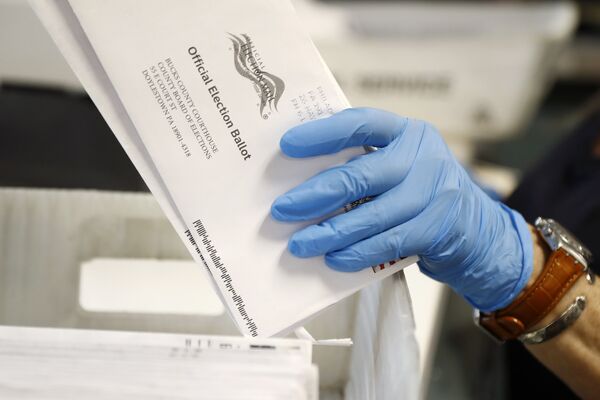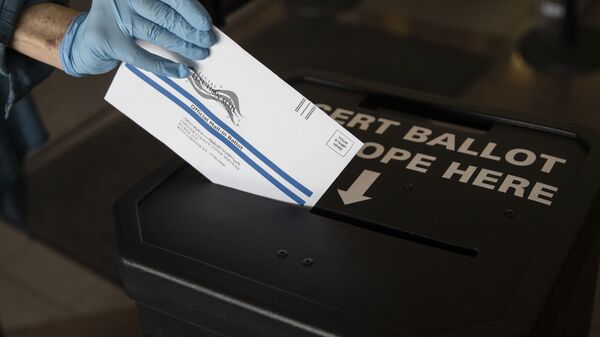A recently-released letter by US Postal Service (USPS) executive vice president Thomas J. Marshall revealed that election officials in 46 US states and Washington DC were warned by postal authorities that American voters were at risk of not being able to deliver their mail-in ballots for November's election poll back to election offices in time for counting due to new policies related to delivery and state deadlines set for receiving the ballots.
The US mail-in voting system, which has now been made available to 76% of American voters, according to analysis by the New York Times, may sound easy in theory. However, it has its outspoken critics, including US President Donald Trump himself, who recently suggested that the November election could be moved to avoid alleged frauds associated with mail-in ballots. So what’s behind this system of postal voting which POTUS hates so much?
Types of Systems
Certain American states have a so-called “universal vote-by-mail” system where ballots are sent out to all registered voters. Before the coronavirus pandemic, five US states used this principle – Colorado, Hawaii, Oregon, Utah and Washington. With the COVID-19 health crisis, four more states have joined - California, Vermont, New Jersey and Nevada, with the last one being seen as a real “battleground” for presumptive Democratic nominee Joe Biden and incumbent President Donald Trump.
Montana, Nebraska and North Dakota are also yet to decide whether ballots will be sent out to all registered voters. According to NYT analysis, around 18% of US voters are set to automatically receive a mail-in ballot.

Another system of postal voting is an “absentee balloting”, where registered voters need to request an absentee ballot in advance. According to the National Conference of State Legislatures, in two-thirds of American states any registered voter can resort to this system without any conditions, while in the rest of the states a legible excuse will be required, such as being sick or being out of the state on Election Day. Some voters may even be added to a permanent absentee ballot list.
According to estimates, around 36 US states, apart from those using universal mail-in-voting, have now either resorted to no-excuse absentee voting or made rules to make it easier to get an absentee ballot amid concerns related to COVID-19.
It is believed that in 2016, nearly 33 million US votes were cast through postal voting using one of these two systems.
How ‘Absentee Balloting’ Works
In states which have not opted for universal mail-in-voting, those eager to avoid queues at polling stations and would rather vote by post, can either write, call or make an online application to receive an absentee ballot from their local election authority. If no excuse is required to take part in this process, voters then simply need to provide their name and home address to receive a ballot.
After a verification process, local election authorities send a ballot to the voter in advance, alongside a security envelope for the ballot to keep the choice private and anonymous and another envelope where the sealed ballot will be placed. The second envelope will need to be signed by the voter to make it clear that he or she is indeed a registered voter.
The voter then sends his or her ballot to the local election authority, which then checks that their names and whether the person is casting a ballot from the address officially registered with the authority. The sealed ballot is then removed from the outside envelope and added to the pool of all other votes to keep it confidential.
In some states, the deadline for the absentee ballot application has been set as 27 October, to accommodate postal delivery times, Pennsylvania being such an example. All “voted ballots” have to be received by county election office by Election Day on 3 November, however, the US Postal Services now doubts that this will indeed be the case. It has even been suggested that key electoral battleground states such as Pennsylvania, Florida and Michigan would be exactly those that may experience some problems with delays in voting, following warnings by the USPS.
The Democrats know the 2020 Election will be a fraudulent mess. Will maybe never know who won! https://t.co/tEWKJ5NcUj
— Donald J. Trump (@realDonaldTrump) August 15, 2020
Mail-in-voting therefore remains a controversial practice to some observers, who cite potential frauds and too-late results. In June, Dr. Harvey Schantz from the State University of New York told Sputnik that despite allowing more people to take part, checking the validity of mail-in ballots may prove to be more difficult in a tight race. But it is precisely the issue of validity which is considered crucial by those who fear the potential for ballot fraud in November.



